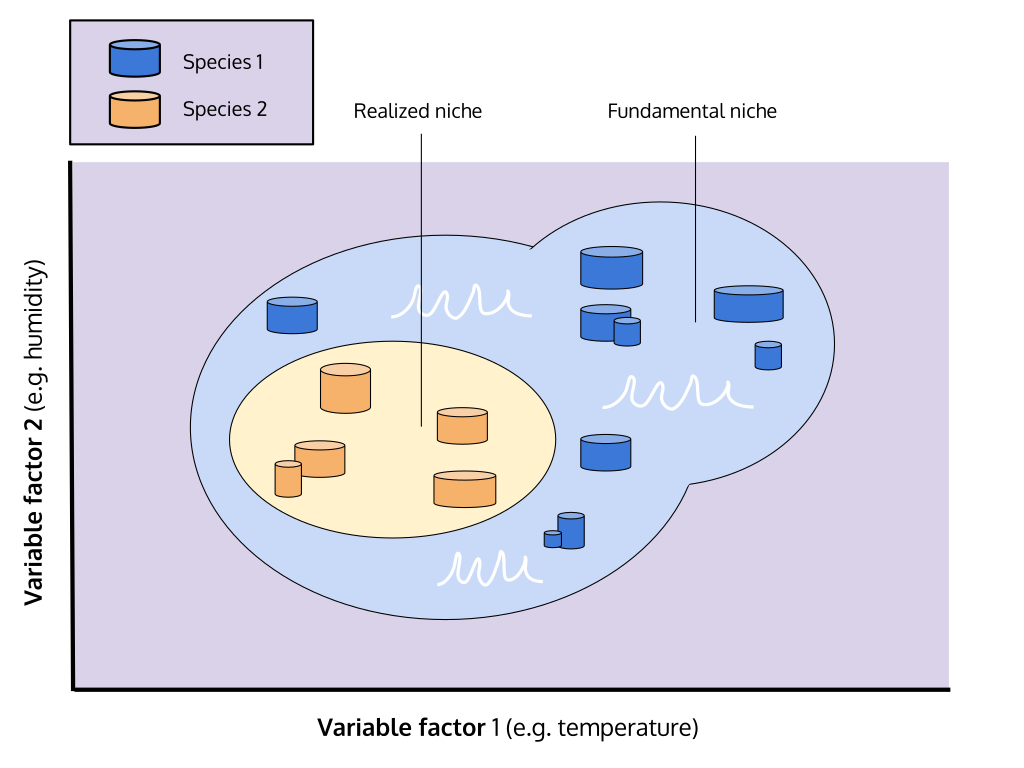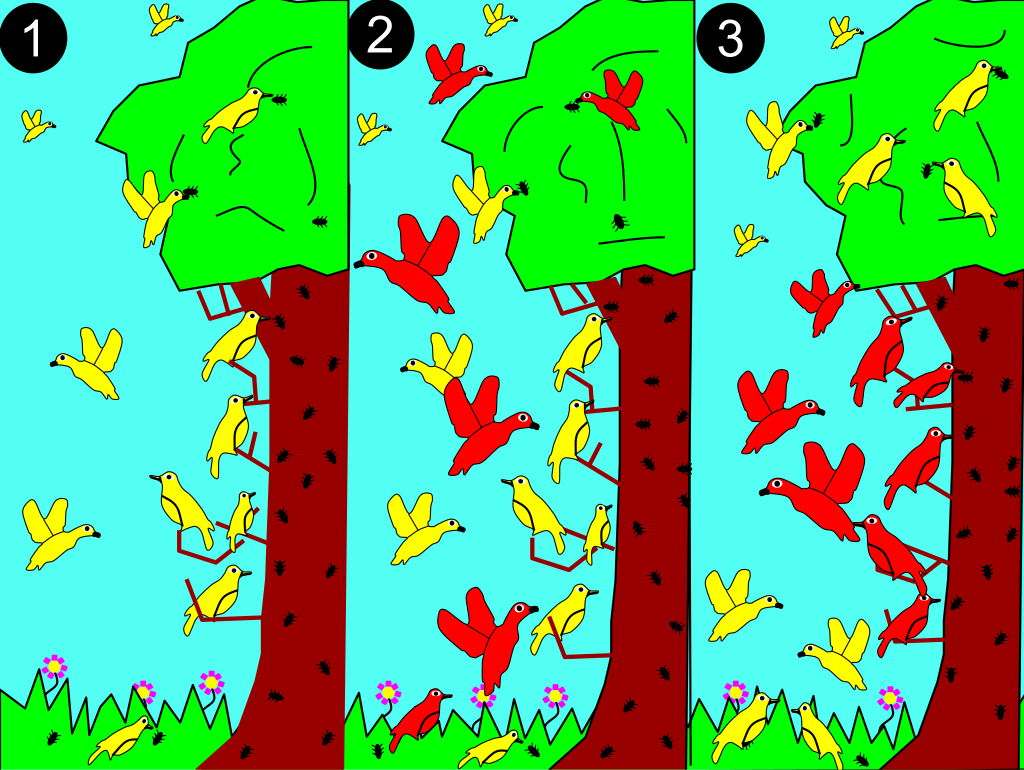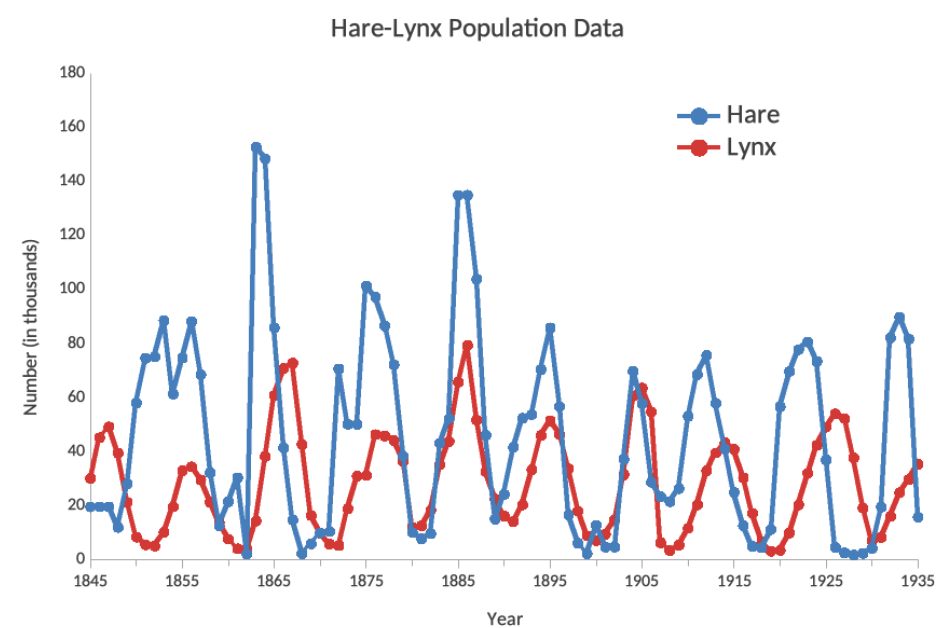IB Syllabus focus:
‘A niche is a species’ role and required conditions/resources. Interactions include herbivory, predation, parasitism, mutualism, disease, and competition; these shape dynamics and selection. Use models (e.g., predator–prey) to explore effects.’
Understanding ecological niches and species interactions is essential in ecology. Niches define how species survive and reproduce, while interactions influence ecosystem structure, stability, and long-term evolutionary pathways.
Ecological Niches
Definition and Concept
Ecological niche: The role a species plays in an ecosystem, including the environmental conditions it requires and the resources it uses.
A niche is not simply where an organism lives, but how it interacts with biotic and abiotic factors. It includes:
Habitat requirements such as temperature range, soil pH, salinity, and water availability.
Resource needs like food, nesting sites, or shelter.
Functional roles including decomposer, predator, pollinator, or primary producer.
Fundamental vs Realised Niche
Fundamental niche: The potential conditions and resources a species could exploit without competition or limiting factors.
Realised niche: The actual conditions and resources a species occupies due to competition and other biotic constraints.
These distinctions are vital for understanding species distribution and community structure.

Diagram of environmental factor space illustrating that a species’ realised niche is a subset of its fundamental niche, constrained by abiotic conditions and biotic interactions (e.g., competition). Labels distinguish two species’ distributions and the nested areas representing potential versus actual occupancy. This directly supports the niche framework used in IB ESS. Source.
Species Interactions
Herbivory
Herbivory: A feeding interaction where animals consume plants or algae, potentially regulating primary productivity.
Herbivores may:
Shape plant community diversity.
Control invasive species by limiting spread.
Influence succession by favouring certain plant species.
Predation
Predation: An interaction where one organism (predator) kills and consumes another (prey).
Predation affects:
Population dynamics, often leading to boom–bust cycles in prey numbers.
Natural selection, as prey evolve defences and predators adapt counter-strategies.
Ecosystem balance, by regulating prey populations and maintaining diversity.
Parasitism
Parasitism: A relationship where one organism (parasite) benefits at the expense of another (host), often without immediate death of the host.
Examples include:
Tapeworms in mammal intestines.
Mistletoe drawing nutrients from host trees.
Parasites can reduce host fitness and alter community structures by suppressing populations.
Mutualism
Mutualism: An interaction where both species benefit.
Examples:
Bees pollinating flowers.
Mycorrhizal fungi enhancing nutrient uptake in plants.
Cleaner fish removing parasites from larger fish.
Mutualism enhances stability by increasing interdependence between species.
Disease
Disease: A condition caused by pathogens (bacteria, viruses, fungi, or parasites) that negatively impacts the host’s survival or reproduction.
Disease can act as a density-dependent regulator of populations.
Epidemics may reduce dominant species, allowing competitors to establish.
Pathogens may influence evolutionary change through selection pressures.
Competition
Competition: An interaction where individuals or species vie for limited resources, reducing fitness for at least one participant.
Two main types:
Intraspecific competition: Between members of the same species, regulating population size.
Interspecific competition: Between different species, potentially leading to competitive exclusion or niche differentiation.

Caption: Three panels illustrate two bird species competing for the same tree resources. Over time, the dominant species occupies the central, resource-rich zone while the other shifts to top and bottom strata—an example of competitive exclusion driving niche partitioning. The visual precisely matches the principle introduced in the notes. Source.
Competitive exclusion principle: No two species can occupy the same niche indefinitely; one will outcompete the other.
Ecological Models
Predator–Prey Models
Predator–prey dynamics illustrate how interactions regulate populations:
Prey increase → predator increase (more food available).
Predator increase → prey decrease (more consumed).
Prey decrease → predator decrease (less food).
This cycle creates oscillating population curves.

Time-series of snowshoe hare and Canada lynx numbers (pelts as a proxy), demonstrating the typical predator–prey cycle with a predator lag. The graph reinforces how biotic interactions can regulate populations and generate oscillations discussed in the model section. Source.
Negative Feedback in Interactions
Predation and competition provide negative feedback, stabilising populations.
Mutualism may provide positive feedback, reinforcing population growth.
Keystone Species
Certain species have a disproportionate impact on ecosystems.
Removing a keystone predator, such as wolves, can cause prey populations to expand unchecked, leading to reduced biodiversity.
Importance of Niches and Interactions
Ecological niches and interactions:
Drive evolutionary change via natural selection.
Influence community composition and succession.
Maintain ecosystem stability through feedback mechanisms.
Ensure the resilience of ecosystems against disturbances.
By analysing species’ roles and relationships, ecologists can better understand how ecosystems function and predict the impacts of environmental change.
FAQ
Adaptive radiation occurs when species diversify rapidly into new niches, often following environmental change or colonisation of new habitats.
For example, Darwin’s finches in the Galápagos evolved distinct beak shapes suited to different food sources, reducing direct competition. By occupying separate realised niches, these birds coexist while exploiting unique resources.
Generalists can survive in a wide range of conditions and utilise varied resources, while specialists depend on very specific requirements.
Generalists (e.g., rats, cockroaches) thrive in disturbed environments.
Specialists (e.g., giant pandas, koalas) are more vulnerable to habitat loss and change.
This distinction highlights how resilience to environmental change depends on niche breadth.
During succession, interactions influence which species dominate and which are displaced.
Early colonisers face little competition, but as more species arrive, competition and predation intensify.
Mutualisms, such as between nitrogen-fixing plants and microbes, accelerate soil development, enabling further colonisation.
Thus, interactions guide the trajectory and speed of community change.
Invasive species often lack natural predators, giving them an advantage in new ecosystems.
They may outcompete native species for food and habitat, altering realised niches. For instance, grey squirrels in the UK displaced red squirrels through competitive exclusion.
By reshaping interactions, invasives can reduce biodiversity and destabilise ecosystems.
Models simulate species distributions by linking niches to environmental variables like temperature and precipitation.
By adjusting these variables under climate scenarios, scientists predict shifts in species’ realised niches. For example, alpine plants may migrate upslope, while polar species lose habitat entirely.
Such models guide conservation planning by identifying vulnerable species and potential future refuges.
Practice Questions
Question 1 (2 marks)
Define the term ecological niche and explain the difference between a fundamental niche and a realised niche.
Mark scheme:
1 mark: Correct definition of ecological niche (the role of a species in an ecosystem, including required conditions and resources).
1 mark: Clear distinction between fundamental niche (potential range without competition) and realised niche (actual range constrained by biotic interactions).
Question 2 (5 marks)
Using named examples, explain how interactions such as predation, competition, and mutualism influence population dynamics and ecosystem stability.
Mark scheme:
1 mark: Explanation of how predation regulates prey populations and maintains balance.
1 mark: Example provided (e.g., lynx and hare cycles).
1 mark: Explanation of how competition shapes niches, including competitive exclusion or niche differentiation.
1 mark: Example provided (e.g., bird species occupying different parts of a tree).
1 mark: Explanation of how mutualism promotes stability (e.g., bees and flowers, cleaner fish and larger fish).

